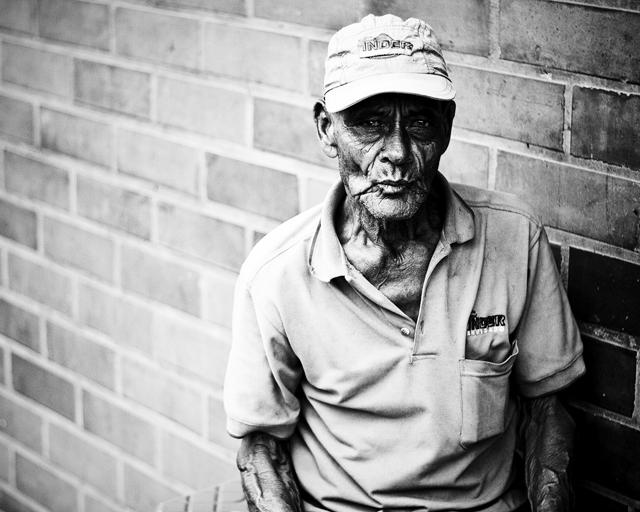Not all stories come in black-and-white, with explicit explanations and blatant presumptions. Neither do Austin Simmons’ stories, conveyed through his two-toned photos.
Simmons, a sophomore in graphic design, now has a collection of his photographs displayed at Vintage 21, a church with a gallery and community center located in downtown Raleigh.
Simmons sees photography as a way to reveal the stories of the overlooked and disadvantaged in society. His current exhibit, entitled “Persons of Pulchritude,” will be on display until the end of the month.
The featured images present the weight of positive attitudes of the impoverished despite adverse living conditions. Simmons took these photos while traveling through South America during the summer with classmates in the Caldwell Fellows Program.
“I was in Medellin, Colombia and then in Ecuador,” Simmons said. “What struck me was how the people, in spite of their economic standing, expressed themselves with happiness.”
Simmons stayed with friends native to Medellin, and during his travels he worked at a children’s home serving as an orphanage and a community center.
“The orphanage was called La Casa de Elena y Juan,” Simmons said, “and it was a great place to work and get great candid shots of people.”
Persons of Pulchritude highlights the carpe-diem attitudes expressed by the people that Simmons encountered and the black-and-white nature of the photos draws parallel in the ambivalence of happiness and hardship.
“I admire the mentality of many of the people that I met,” Simmons said. “If I take that mentality and apply it on my own, I think that it’s really important to make sure that you’re content and put other priorities in place. “
Visually expressing this feeling was the gist of Simmons’ work. The photographer explained that pictures are commonly taken for granted in the U.S., but not everyone has this luxury.
“Walking around the city of Medellin, you don’t see a lot of people with cameras,” Simmons said, “but a lot of people were receptive about getting their photos taken.”
After ending his stint in Columbia, Simmons continued his travels and photography as he bused 30 hours to neighboring Ecuador. There, he visited the mountains and the country’s eastern rainforest.
Simmons’ work portrays people who aren’t likely to be photographed under normal conditions, due to limited resources. However, Simmons did not limit himself to expressing this for South Americans only. Not everyone can take part in photography and despite the over 30 billion shared photo albums each month on Facebook, there are many people without means to acquire their portraits.
This fact spurred Simmons to set up Help Portrait in Raleigh. Begun by Nashville, TN-based photographer Jeremy Cowart, Help Portrait provides portraits for the homeless and for needy families. The event came to Raleigh last year with the help of Simmons and his friend Andrew Vanover, a junior in mechanical engineering.
“Help Portrait created a vision and a type of structure, but from there we organized the rest,” Simmons said. “Photography is just such a powerful means to reach people.”
The event, which took place at Vintage 21 on December 4th, 2010, was comprised of a team of 100 volunteers and over 150 individuals getting their portraits.
“There was some initial criticism,” Simmons said. “People have argued that the physical and food needs of the homeless are much more demanding than for just a photograph that they can carry around. The argument is that a picture, although it isn’t food they can eat or a blanket that can keep you warm, is something that provides a feeling that they probably haven’t experienced.”
Eric Reed, a junior in civil engineering, volunteered at the event last year.
“Hope Portrait was one of the coolest things I’ve been a part of here in Raleigh, NC,” Reed said. “I was a photographer assistant, helping with lighting and so forth. It was rewarding and was a good chance to love on people that don’t necessarily get much affection.”
Reed commented that images from “Persons of Pulchritude” show a similar feel to the works from Help Portrait.
“I remember thinking that Austin had a recognizable feel for his pictures,” Reed said.
“Image are very powerful things. When you add a face to someone’s story of feelings, it adds a lot of weight. When you see it, it makes it more powerful. It’s encouraging to see the positivity in ‘Persons of Pulchritude.'”
Kyle Jones, a sophomore in nutrition sciences, stopped by Vintage 21 during the First Friday event of February, in which galleries and restaurants downtown offer discounts that conduce free-form tours.
“I was really impressed with the work and it was nice to see the photos of people who don’t necessarily have access to that exposure,” Jones said. “The pictures really stuck with me and I still remember the photographer’s style.”








